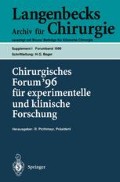Zusammenfassung
Nach dem gegenwärtigen Forschungsstand wird die hyperakute Abstoßung von Xenotransplantaten in diskordanten Specieskombinationen durch präformierte Antikörper vermittelt, die das Komplementsystem aktivieren. Am Ende der Aktivierungskaskade zerstört ein Proteinkomplex (Membrane Attack Complex) die Endothelzellmembranen des Xenotransplantates. Cobravenomfaktor inaktiviert das Komplementsystem und verzögert die hyperakute Abstoßung von Minuten auf Tage. Er verändert letztendlich aber nicht das histologische Bild der Abstoßung [1]. Es ist also unklar, welcher Mechanismus zur verzögerten hyperakuten Abstoßung bei inaktiviertem Komplementsystem fuhrt. Unter der Vorstellung, daß Antikörper ohne Vermittlung des Komplementsystems über die Antikörper-vermittelte zelluläre Zytotoxizität (ADCC) Zellschäden auslösen und die verzögerte Abstoßung bewirken, setzten wir Plasmapherese und Cobravenomfaktor einzeln oder modifiziert-kombiniert ein. Dadurch wurde bei inaktivertem Komplementsystem zusätzlich der Antikörperspiegel reduziert. Völlig unerwartet war die Intervallkombination mit zweitägigem Abstand am wirkungsvollsten, obwohl zu diesem Zeitpunkt die Antikörperspiegel wieder rekonstituiert waren.
Access this chapter
Tax calculation will be finalised at checkout
Purchases are for personal use only
Preview
Unable to display preview. Download preview PDF.
Literatur
Adachi H, Rosengard BR, Hutchins GM, Hall TS, Baumgartner WA, Borkon AM, Reitz BA (1987) Effects of Cyclosporine, Aspirin and Cobra Venom Factor on Discordant Cardiac Xeno-graft Survival in Rats. Transplant Proc 19:1145 -1148
Blakely ML, Van der Werf WJ, Berndt MC, Dalmasso AP, Bach FH, Hancock WW (1994) Activation of Intragraft Endothelial and Mononuclear Cells during Discordant Xenograft Rejection. Transplantation 58:1059–1066
Fryer JP, Leventhal JR, Dalmasso AP, Chen S, Simone PA, Goswitz JJ, Reinsmoen NL, Matas AJ (1995) Beyond Hyperacute Rejection. Accelerated Rejection in a Discordant Xenograft Model by Adoptive Transfer of Specific Cell Subsets. Transplantation 59:171 -176
Heron I (1973) A Technique for Accessory Cervical Heart Transplantation in Rabbits and Rats. Acta Pathol Scand 79:366
Reding R, Davies HS, White DJG, Wright LJ, Marbaix E, Alexandre GPJ, Squifflet JP, Calne RY (1989) Effect of Plasma Exchange on Guinea-Pig-to-Rat Heart Xenografts. Transplant Proc 21:543–536
Author information
Authors and Affiliations
Editor information
Editors and Affiliations
Rights and permissions
Copyright information
© 1996 Springer-Verlag Berlin · Heidelberg
About this paper
Cite this paper
Grimm, H., Mages, P., Lindemann, G., Potthoff, M., Bohnet, U. (1996). Welche Faktoren bewirken die hyperakute Xenotransplantat-abstoßung bei inaktiviertem Komplementsystem, noch bevor zelluläre Mechanismen einsetzen?. In: Beger, H.G., Birk, D., Staib, L., Pichlmayr, R., Seifert, J., Hartel, W. (eds) Chirurgisches Forum ’96 fur experimentelle und klinische Forschung. Langenbecks Archiv für Chirurgie, vol I/96. Springer, Berlin, Heidelberg. https://doi.org/10.1007/978-3-642-80138-9_33
Download citation
DOI: https://doi.org/10.1007/978-3-642-80138-9_33
Publisher Name: Springer, Berlin, Heidelberg
Print ISBN: 978-3-540-60905-6
Online ISBN: 978-3-642-80138-9
eBook Packages: Springer Book Archive

